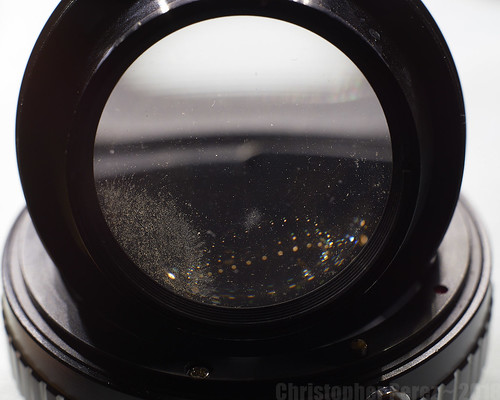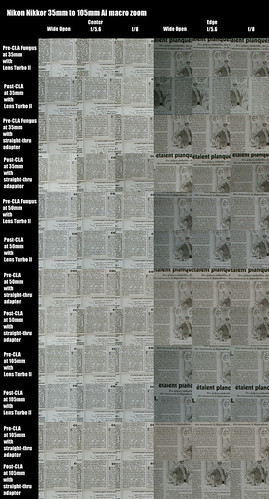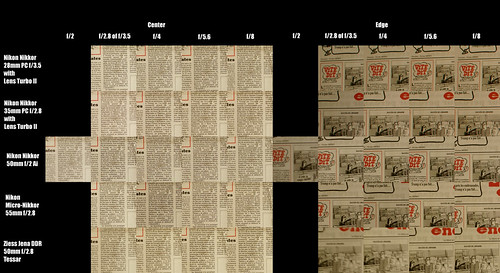The insanity continues.
A friend recently sent me his old Nikon Micro-Nikkor 55mm f/2.8 Ai. I already had a copy of the earlier lens, a 55mm f/3.5 pre-Ai.
Playing around, I took a look at how well these worked with a 52mm threaded reverse adapter that flips the lens around on a camera. I learned that the adapter worked best when the subject to lens distance was shorter than the focal length (otherwise the edges went soft very quickly). But for everything else macro a normally oriented lens worked best.
In general use, I couldn't help but notice the f/3.5 "felt" sharper wide open than the f/2.8 at f/2.8. But stopped down, everything was brilliantly sharp out of both lenses.
Macro is not what I do, but, still playing around and wondering about "things" I thought it might be fun to see how the two Micro-Nikkor lenses behaved at 1:2 magnification (as marked on each lens).
Setup -
Comparison Results -
[If you click on the image it'll take you to the Flickr hosting site. Once there, look at the file at full resolution. In many cases the differences between lenses is small and likely can't be seen until you take a squint at the comparison at 100 percent.]

Comments -
Indeed, the Micro-Nikkor 55mm f/2.8 shot at f/2.8 is softer than it's brother lens shot at f/3.5. The difference isn't that great, but it is noticeable (otherwise why comment on it, right?).
However, the f/2.8 lens at f/4 is sharper than the f/3.5 at f/3.5.
From f/5.6 on down both lenses look nearly identical.
One of the things I like about shooting with a Micro-Nikkor is that the image field is flat and without distortion. Images can be sharp all the way to the edge and I don't have to apply pincushion/barrel distortion corrections. As a bonus, the out of focus rendition of both lenses shot wide open is very smooth and creamy. I like this since many 50-58mm lenses suffer from over corrected out of focus regions which leads to "soap bubble bokeh".
I suppose I should, for completeness, take a look at how both lenses compare at more normal photography working distances.
A friend recently sent me his old Nikon Micro-Nikkor 55mm f/2.8 Ai. I already had a copy of the earlier lens, a 55mm f/3.5 pre-Ai.
Playing around, I took a look at how well these worked with a 52mm threaded reverse adapter that flips the lens around on a camera. I learned that the adapter worked best when the subject to lens distance was shorter than the focal length (otherwise the edges went soft very quickly). But for everything else macro a normally oriented lens worked best.
In general use, I couldn't help but notice the f/3.5 "felt" sharper wide open than the f/2.8 at f/2.8. But stopped down, everything was brilliantly sharp out of both lenses.
Macro is not what I do, but, still playing around and wondering about "things" I thought it might be fun to see how the two Micro-Nikkor lenses behaved at 1:2 magnification (as marked on each lens).
Setup -
- Sony NEX-5T, 100ISO, AWR converted in Sony's software
- Big Beefy Manfrotto tripod
- Nikon Micro-Nikkor 55mm f/2.8 Ai
- Nikon Micro-Nikkor 55mm f/3.5 pre-Ai
Comparison Results -
[If you click on the image it'll take you to the Flickr hosting site. Once there, look at the file at full resolution. In many cases the differences between lenses is small and likely can't be seen until you take a squint at the comparison at 100 percent.]

Comments -
Indeed, the Micro-Nikkor 55mm f/2.8 shot at f/2.8 is softer than it's brother lens shot at f/3.5. The difference isn't that great, but it is noticeable (otherwise why comment on it, right?).
However, the f/2.8 lens at f/4 is sharper than the f/3.5 at f/3.5.
From f/5.6 on down both lenses look nearly identical.
One of the things I like about shooting with a Micro-Nikkor is that the image field is flat and without distortion. Images can be sharp all the way to the edge and I don't have to apply pincushion/barrel distortion corrections. As a bonus, the out of focus rendition of both lenses shot wide open is very smooth and creamy. I like this since many 50-58mm lenses suffer from over corrected out of focus regions which leads to "soap bubble bokeh".
I suppose I should, for completeness, take a look at how both lenses compare at more normal photography working distances.



